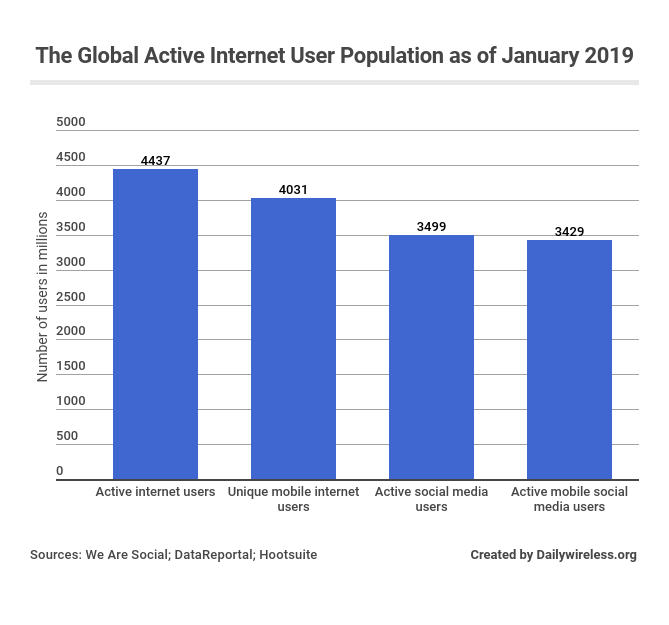Why Digital Media is Killing TV Advertising
In 2018, research conducted by the Leichtman Research Group found that 78% of households still watch traditional satellite or cable TV.
Looking at that statistic, you wouldn't think that TV viewing is on the decline -- but it is, and with it, TV ad spend.
For instance, considering research from the same group in 2018, you'll see 69% of homes in 2018 were subscribed to a video streaming service -- which is up from 52%, just two years prior.
On top of all that, internet usage itself has risen to over four billion users since last year. That number encompasses over half of the global population, with China, India and the United States ranking ahead of all other countries in terms of internet users.
Download Now: HubSpot's Annual State of Marketing Report

Image Source
Traditional TV viewing has dropped dramatically since 2012, particularly among 18-24 year olds. In the next few years, we're going to continue to see a decline of TV viewing -- and with it, a steep drop-off of traditional TV advertising in favor of using digital media as the preferred advertising platform.
Here, I'm going to explain why.
The Decline of TV Advertising
TV advertising spend actually climbed 16% from 2010 to 2017, according to analysis by ARK Investment Management. And yet, conversely, TV viewing decreased in that time by 20%.
In years past, TV was the only form of media you could use to reach a massive market during prime hours -- but now, people aren't watching as much.
The way we see it, there are a few components to this shift.
First, a study by Omnicom Media Group's Hearts & Science agency found that nearly half of Millennials and Gen Xers are no longer viewing video content on traditional TV.
Instead, they are choosing to view content on newer streaming platforms -- Netflix, Hulu, Amazon Prime, and YouTube TV, which have been taking over the viewing space.
In fact, on average, they're consuming 30 hours of video content on streaming platforms per week. This makes these generations "unreachable" through traditional advertising methods, particularly since most streaming platforms, like Netflix, don't allow brands to advertise on the site.
Additionally, when these audiences do watch regular TV, they aren't solely engaged in the show -- for instance, on commercial breaks they're likely to pull out their phones or other devices, so they might not remember or watch TV commercials at all.
If these losses continue as projected, by 2023 viewing hours could be less than half what they were in 2010, and cut in half again by the year 2028.
ARK’s research suggests that if marketers begin to take these dropping viewing hours into account and continue to shift their budgets toward digital methods, the United States' TV ad revenue could plummet to less than half its current levels over the next 10 years.
The Rise of Digital Advertising
In contrast, online streaming platforms have been experiencing massive growth. For example, YouTube TV increased its viewership by more than 10X between 2010 and 2017.
Even social networks like Facebook and Twitter are creating their own versions of video streaming.
In addition, in 2019, digital ad spending will surpass TV ad spend, and traditional ad spend, for the first time ever. It's also projected that by 2023, digital will exceed two-thirds of total media spending.
But why exactly is this happening? Why the shift? Let's dive into that further. Here, I'll outline five reasons digital ad spending is surpassing traditional.
1. Digital media is cheaper.
The cost difference between TV advertising and digital marketing methods is tremendous. A 30-second TV ad -- which may or may not reach your ideal audience -- will cost you over one-third of a million dollars ... plus setup costs.
In contrast, while you need to hire employees to conduct SEO and potentially invest in SEO products, SEO itself is free, and can help you organically reach your target audience over the long-term. PPC and email marketing have cheap set-ups, and could cost anywhere from a few cents per click to a few dollars.
Frankly, that sort of disparity -- while it makes sense logistically -- is fairly ludicrous.
2. Digital marketing allows for better segmentation.
Traditional TV advertising lets you broadcast to anyone who turns on the channel. To reach a specific audience to whom your product will appeal, you need to guess what sort of TV programming could appeal to your ideal demographic -- it's difficult to apply or collect any audience-specific analytics.
With TV advertising, the closest you can get to understanding a TV channel's audience is through ratings like Nielsen ratings or the Gross Ratings Point. These ratings are used to estimate the percentage of the desired demographic on a particular channel through statistically relevant sampling.
Comments
Post a Comment